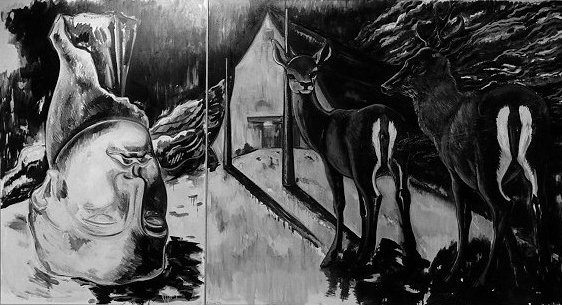



- Énoncé de l'artiste : Rebecca Burke
In rural New Brunswick, the white-tailed deer is a relative newcomer. Prior to Confederation there were no deer in Nova Scotia and few in New Brunswick. Since then human activities, including the cutting and burning of forests, the seeding of agricultural crops, the winter feeding of cattle combined with the long term easing of severe winters, have helped extend the deer's range northward from the most southerly parts of Canada and has led to a substantial increase in numbers.
This information is secondary to the paintings, the result of research after the fact, although it is tempting to speculate that the intuitive choice of an image is somehow related to the mythology and folklore of the past.
The paintings were done in a two and half year period, resulting in a somewhat tenuous connection between the individuals in the group. Many come from direct experience or observation - the anthropomorphic quality of some industrial structures; or a simple lesson learned, wood ashes should not be emptied into cardboard boxes. The experience acts as a trigger which calls forth an image - a mental picture of something not actually present which through the act of painting becomes concrete. In some cases the "mental picture" called forth attempts a symbolic representation of larger concepts - for example, nature or culture, which have no set or concrete form.
In the painting Encounter the simple symbolic structure - the pairing of the figures - Adam/Eve (man) with the buck/doe (nature) and the columns (culture) was fleshed out for me, by research. Adam and Eve were meant for immortality, but after eating the forbidden fruit, death became their lot; the animals no longer obeyed them; but feared and attacked them. An Arabian story of Adam and Eve remarks on their cleverness; at the moment of expulsion from Eden they remember to grab up an anvil, two hammers, a pair of tongs and a needle.
I live in Point de But, a small community near Sackville, New Brunswick, east across the Tantramar Marshes. The daily drive to and from work along the Trans Canada takes me through a rather sparse, flat, grassed landscape with a big sky. Domestic animals such as cattle and horses and occasionally exotic wild life - deer, fox, pheasant and heron share the same physical space as tractors, front end loaders, caterpillars, backhoes and the ubiquitous transport truck. As the highway is turned from a two to four lane road, the ten minute drive often brings together in quick succession disparate glimpses of a dramatic, natural landscape and the man made landscape of heavy machinery and construction debris as whole hill sides are virtually ripped apart and reassembled in a straight line to form the base for the road. Once the tranformation is complete, the road finished and the hill side has healed itself with new growth, the contradictions of human existence which is a borth constructive and destructive act in terms of its ramifications for our surroundings will become less apparent or even disappear.
But for the present on my daily journey, I am struck by the paradox that as we create culture, we destroy nature. We can define culture in its broadest anthropological sense as our distinctly human means of survival, the sum of all ou learned, and shared behavious: how we make a living, produce things, organize our societies, and use language and other symbolic forms. With our anvil, hammer, tongs and needle, the first primitive power plan of the preindustrial world we accomplished our transformation from the godlike creatures in the garden of Eden to our present animal/human form with a complex, industrial and technological society. Painting/art can still function as part of our language of symbolic forms. Like the story of the deer wife or the "woman who was a deer", we can be called back from our transformation to our animal selves in either the worst or the best sense; to inhabit our natural and cultural skin in beneficial co-existence or in destruction.
The paintings can only point to or gesture to these ideas in the most general way.
The deer is a potent image, for me, a symbol of nature, strong and swift, fragile and vulnerable. The deer is also a popular character in the mythology of many western tribes of native North America as well as in Greek mythology and Irish and Scottish folk tales. Transformation is often part of the deer mythology; in some tales deer are referred to as a male being, in others, as a female being, the mother, wife or sister of some other animal character. One widespread tale is that of the marrige of a man to a deer wife; the wife is finally offended (as animal wives often are in North American Indian tales) by some remarks concerning her eating habits and leaves her husband after bearing him a son. In another Pueblo Indian story, an abandoned baby is raised by "a woman who was a deer". Raised among her own fawns the child becomes strong and swift, but is eventually captured by hunters and returned to his mother. To rejoin his human family he must remain unseen in a room for four days, but the mother becoming impatient, peeks and the child takes on deer-form and runs north to join his Deer mother.
-
BURKE, Rebecca
«Night in PT De Bute»
©1992
183 x 335 cm (6 x 11 pieds)
Peinture

 retour à la liste
retour à la liste